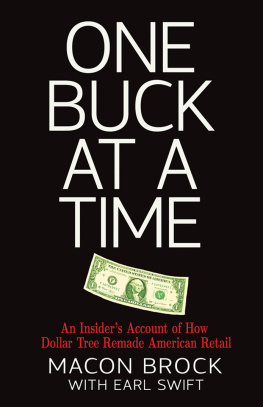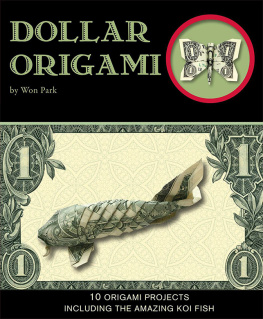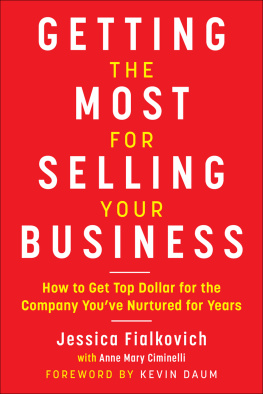

Beachnut Publishing
Virginia Beach, Virginia
Copyright 2017 by Macon Brock
Distributed by John F. Blair, Publisher
1406 Plaza Drive
Winston-Salem, North Carolina 27103
blairpub.com
Dollar bill on front cover: aodaodaodaod/Shutterstock
Back cover photo: Lawrence Jackson, The Virginian-Pilot
Library of Congress Cataloging-in-Publication Data
Names: Brock, Macon, 1942- author. | Swift, Earl, 1958- author.
Title: One buck at a time : an insiders account of how Dollar Tree remade American retail / by Macon Brock, with Earl Swift.
Description: Winston-Salem, North Carolina : John F. Blair, Publisher, [2016] | Includes bibliographical references and index.
Identifiers: LCCN 2016032344 (print) | LCCN 2016038177 (ebook) | ISBN 9780895876812 (hardcover : alk. paper) | ISBN 9780895876829 (ebook)
Subjects: LCSH: Dollar Tree (Firm) | Variety stores--United States. | Discount houses (Retail trade)--United States. | Retail trade--United States.
Classification: LCC HF5465.U64 D6537 2016 (print) | LCC HF5465.U64 (ebook) | DDC 381/.14906573--dc23
LC record available at https://lccn.loc.gov/2016032344
10 9 8 7 6 5 4 3 2 1
For Joan
Contents
T his is the story of a great American company and the people who made it.
It is a company that has grown into a behemoth over the past few years and today boasts a presence throughout the contiguous United States and Canada. It offers something for everyoneman or woman, young or old, rich or poor, urban or ruralat a price that simply cant be beaten. Few American towns of decent size are untouched by its existence. Those that are wont be for long.
From more than six thousand storefronts, it provides millions of people a day with essential household fare, stationery, gifts for their friends and loved ones, toys and clothing for their children. Those goods, piled together over the course of a year, would dwarf the Great Pyramid. The retail space in its stores totals more than 45 million square feet, an area significantly bigger than New Yorks Central Park. Its work force has more than doubled in five years, to upwards of ninety thousand peoplea population equal to that of Asheville, North Carolina, or Fargo, North Dakota, and bigger than that of several countries. Seriously, its more than twice the size of Lichtenstein.
A surprising number of the tractor-trailers on the interstates carry its goods. Just one of its eleven warehouses moves a million cartons of merchandise per week, and in each of those cartons are up to five dozen items that will wind up on the shelves, and are almost sure to move off them quickly. In 2014, the company posted nearly $8.6 billion in sales, which is to say that it sold 8.6 billion pieces of merchandisean easy piece of math, because each and every one of its products sells for no more than a buck.
Not bad for a business that started as an experiment, and one that precious few experts thought would work.
Now, this company, Dollar Tree, is putting the finishing touches on a corporate merger that promises to make all this success look pretty pale. By the time you read this, it will have more than fourteen thousand stores and pull in $20 billion in sales. That would make it significantly bigger than Eli Lilly or Southwest Airlines or Kraft Foods.
Itll be exciting to see what happens. Regardless of the outcome, though, this is less a story about a company rising steadily through the Fortune 500 than it is one of humble beginnings, because thats the real miracle of Dollar Tree: not how big and successful it is today, but how unlikely its good fortune seemed just a few years ago.
Its the story of an unassuming man from the North Carolina sticks who came to a cityNorfolk, Virginiato learn how to cut hair and stuck around to open a barbershop. Its the story of how he parlayed that shop into a busy little knot of enterprises after World War II, among them an old Ben Franklin variety store. Its the story of how he enlisted his family into the business, and then a cadre of loyal staffmany of whom were in high school when they signed on, and most of whom didnt have a lick of college creditand how, together, they worked long days against long odds to build something out of next to nothing.
Its a story I know well, because I was part of it. That barber was my father-in-law. Today, Im the chairman of Dollar Trees board of directors. For many years, I served as the companys president and chief executive officer. I was its public face as we demonstrated, year after year, that the idea at the heart of the businessthat we could price quality merchandise that consistently surprised and delighted customers at just one dollar, and hold to that price no matter whatwasnt as crazy as it first seemed.
Which is one of the reasons its important to me to tell this story now. Because I was Dollar Trees spokesman in the press and its face to the public, I got much of the credit for the companys success. Dollar Tree and Macon Brock became synonymous in a lot of peoples minds. And thats not how it was.
Im no genius. I didnt come up with the dollar-store idea and cant claim any flashes of brilliance that transformed one tiny store into a national chain. I worked hardhell, I worked my ass offbut so did the people around me. Trite though it sounds, I was part of a team. It was a small team early on, and a bigger one later, but always a real team. Every member was essential to what we created, and everyone lived and worked by principles that we came to value together. Do your best. Do the right thing. When in doubt, choose the solution that works best for the long term.
Being the boss, or one of the bosses, was only so important. What made the difference, and made the company, was collective effort. We allfrom buyers to warehouse workers, store managers to computer whizzes, accountants to payroll clerkswere the creators of Dollar Tree. We shared a sense of mission. We embarked on an adventure that we werent sure would end the way we wanted it to, but we were united in giving it our best shot. In the process, we became closer than most families.
So before my memory starts to slip, I want to assign the credit for our success to the people who made it happen. Ill narrate the proceedings, and in the course of doing so Ill share my own meandering journey to and from that Ben Franklin store that started it all. But make no mistake, this is our story, not just mine.
I have a second, related motive. Today, with the company grown beyond our wildest imaginings, most of us are retired or have moved on to new ventures; only a few members of the team still go to work every day in Dollar Trees offices. And while I have nothing but admiration for the many ways that our successors have built on what we started, not to mention the spectacular results theyve achieved, I worry that the excitement and drama and sheer improbability of the early days will be forgotten once the last of us leaves.
I dont want that to happen. A company is more than an engine for delivering bags of cash to its stockholders. In America especially, its among the most important building blocks of society. We each might go to work every day because we have to pay the rent, but we alsoif we work at a good companyshare a sense of purpose with our coworkers.
Building and sustaining that sense of purpose, that culture, requires an awareness of history. You can understand yourself only so much if you know nothing of your parents, the circumstances of your birth, your early childhood. Traditions mean little if you dont understand where they came from, and why its important that you stick to them or challenge them and start new ones.
Next page










